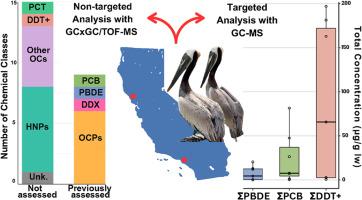Targeted and Nontargeted Approaches to Uncover Complex Halogenated Pollutants in the Historically Endangered California Brown Pelican
IF 7.3
2区 环境科学与生态学
Q1 ENVIRONMENTAL SCIENCES
引用次数: 0
Abstract
Historically, California Brown Pelicans experienced reproductive failure and population decline induced by the pesticide dichlorodiphenyltrichloroethane (DDT). Although the population recovered after the 1972 DDT ban, nontargeted analytical methods have identified over 45 DDT-related compounds (DDT+) and other typically unmonitored halogenated organic compounds (HOCs) in regional upper trophic level wildlife species, presumably originating from the persistent and chemically-complex DDT manufacturing waste deposited in the southern California Bight (SCB). However, there is limited data on DDT+ in previously endangered bird populations, including the brown pelican. We identified 183 HOCs in seven brown pelican liver samples (131 ± 48, mean ± SD) via nontargeted analysis. Seventeen DDT+ compounds were identified, including four tris(4-chlorophenyl)methane (TCPM)-related compounds, and 17 polychlorinated terphenyls (PCTs), all of which were not assessed in prior pelican research. Quantitative targeted analysis was conducted for three classes: DDT+, polychlorinated biphenyls (PCB), and polybrominated diphenyl ethers (PBDE). Among these three classes, DDT+ was the dominant chemical class (∑13DDT+, 0.56 – 197 μg/g lw), followed by (∑14PCB, 0.24 – 96 μg/g lw), and (∑6PBDE, 0.01 – 5.61 μg/g lw). ∑13 DDT+ primarily consisted of p,p’-DDE (77% ± 15%), 4,4’,4”-TCPM (12% ± 10%), p,p’-DDMU (6% ± 3%), and 4,4’,4”-TCPMOH (5% ± 6%). These results demonstrate the continuous exposure of known historical HOCs and a chemically diverse set of under-monitored HOCs, including DDT+. Additionally, levels of detection are consistent with recent wildlife studies in the region, suggesting pervasive contamination of a unique profile of HOCs throughout the SCB food web.

在历史上濒危的加利福尼亚褐鹈鹕中发现复杂卤化污染物的目标和非目标方法
从历史上看,加州褐鹈鹕经历了农药DDT导致的繁殖失败和种群减少。尽管种群在1972年DDT禁令后恢复,但非目标分析方法已经在区域上营养级野生动物物种中发现了超过45种DDT相关化合物(DDT+)和其他通常未监测的卤化有机化合物(hoc),可能源于沉积在南加州海域(SCB)的持久性和化学复杂的DDT制造废物。然而,在包括褐鹈鹕在内的先前濒危鸟类种群中,关于DDT+的数据有限。通过非靶向分析,在7份褐鹈鹕肝脏样本中鉴定出183种hoc(131±48,mean±SD)。共鉴定出17种DDT+化合物,包括4种与三(4-氯苯基)甲烷(TCPM)相关的化合物和17种多氯联苯(PCTs),这些化合物在之前的鹈鹕研究中都没有被评估过。对滴滴涕+、多氯联苯(PCB)和多溴联苯醚(PBDE)三大类进行了定量靶向分析。其中,DDT+为优势化学类(∑13DDT+, 0.56 ~ 197 μg/ lw),其次为(∑14PCB, 0.24 ~ 96 μg/ lw)和(∑6PBDE, 0.01 ~ 5.61 μg/ lw)。∑13 DDT +主要由p, p的dde(77%±15%),4,4’,4“-TCPM(12%±10%),p, p的-DDMU(6%±3%),4,4’,4”-TCPMOH(5%±6%)。这些结果表明持续暴露于已知的历史上的hoc和一组化学多样性的未受监测的hoc,包括DDT+。此外,检测水平与该地区最近的野生动物研究一致,表明在整个SCB食物网中普遍存在一种独特的hoc污染。
本文章由计算机程序翻译,如有差异,请以英文原文为准。
求助全文
约1分钟内获得全文
求助全文
来源期刊

Environmental Pollution
环境科学-环境科学
CiteScore
16.00
自引率
6.70%
发文量
2082
审稿时长
2.9 months
期刊介绍:
Environmental Pollution is an international peer-reviewed journal that publishes high-quality research papers and review articles covering all aspects of environmental pollution and its impacts on ecosystems and human health.
Subject areas include, but are not limited to:
• Sources and occurrences of pollutants that are clearly defined and measured in environmental compartments, food and food-related items, and human bodies;
• Interlinks between contaminant exposure and biological, ecological, and human health effects, including those of climate change;
• Contaminants of emerging concerns (including but not limited to antibiotic resistant microorganisms or genes, microplastics/nanoplastics, electronic wastes, light, and noise) and/or their biological, ecological, or human health effects;
• Laboratory and field studies on the remediation/mitigation of environmental pollution via new techniques and with clear links to biological, ecological, or human health effects;
• Modeling of pollution processes, patterns, or trends that is of clear environmental and/or human health interest;
• New techniques that measure and examine environmental occurrences, transport, behavior, and effects of pollutants within the environment or the laboratory, provided that they can be clearly used to address problems within regional or global environmental compartments.
 求助内容:
求助内容: 应助结果提醒方式:
应助结果提醒方式:


